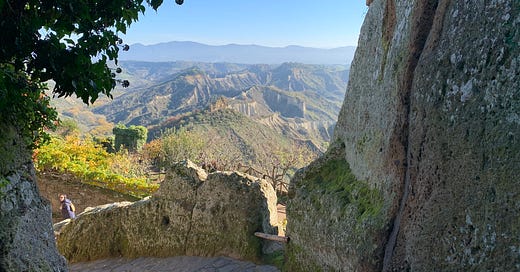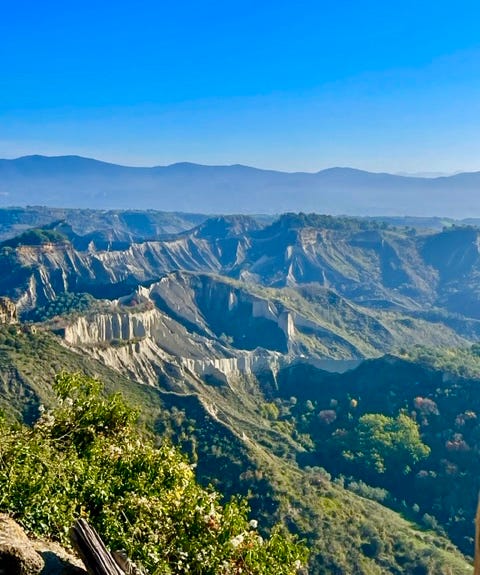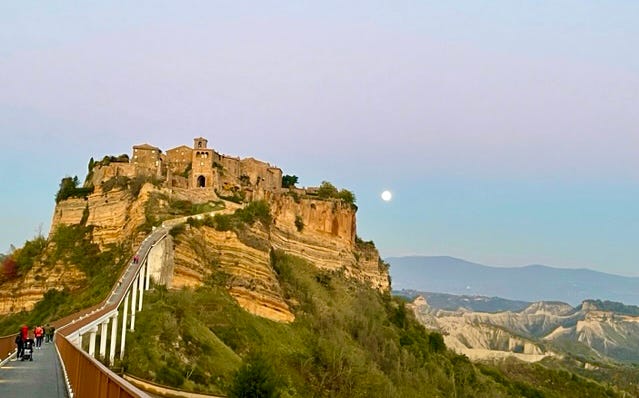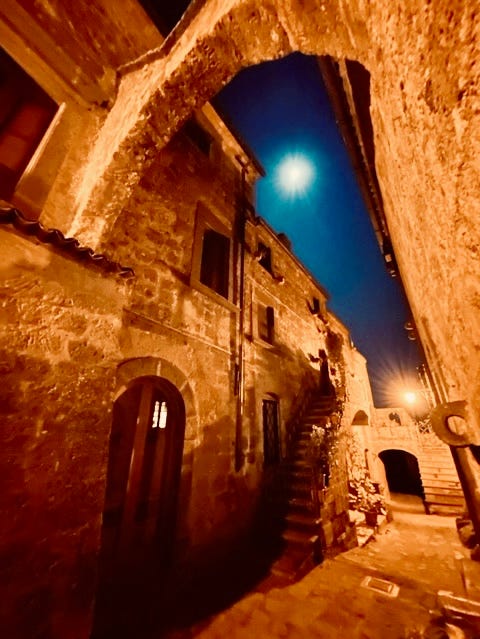I need to preface this second post by saying that I am so grateful to all of you who have subscribed to Life Lived Italian or taken time to look at “Why Italy?”, the post that launched the newsletter. When I initiated the Substack account, I steeled myself for a bi-weekly one on one therapy session—me rattling away to myself, stuffing notes in a virtual bottle and sending them hopelessly out to sea. To have more than 50 subscribers in the first month is much more than I ever could have imagined.
With actual readers comes an opportunity for sharing experiences, thoughts or advice, so I do hope you’ll comment, offer travel tips, and make suggestions. In fact, this week’s post was inspired by a video clip from my friend Geavanya, a Life Lived Italian subscriber. The story reminded me of a place we visited recently, and I decided to share something I wrote at the time. Grazie Geavanya!
Yesterday we saw the sun set on Civita di Bagnoregio The sun has been setting on this diminutive Italian town for a long time, and most had thought the light would be out entirely by now. Its own native son, writer Bonaventura Tecchi, gave it the moniker “the dying city”, a ghost town.
Civita is not the only village condemned to such a fate, not in Italy or in America either. In fact, “ghost towns” have been in the news a bit lately. CNN recently ran a story on San Severino di Centola, another Italian outpost trying to fight its way back to the land of the living.
Of course, Civita has the usual problems: an aging population, minimal economic activity, and an endless list of structural failings. Not unexpected for a village started by the Etruscans more than 2500 years ago.
But Civita di Bagnoregio also faces a more ominous challenge: the unsettling reality of the ground shifting, literally and figuratively, beneath its feet. The town is a decoration at the top of a wedding cake that is being sliced and served from the bottom layer. After centuries of erosion and landslides that have carved away the land upon which it sits, Civita clutches onto a dramatic cliff that overlooks a deep valley below, the Valle dei Calanchi (Valley of the Badlands), completely cut off from its neighbors and even the countryside around it.
The effect is that of a fairy-tale village rising up out of nowhere. But of course, the town isn’t rising at all. Rather, everything around it has fallen away. Civita is the last man standing in a geological game of musical chairs that was lost long ago. Being the shining city on a hill is a spectacular position, but also a dangerously anti-social one.
Ironically, it was location that originally made Civita a thriving city. Situated near the mouth of the Tiber River, the town was at the center of trade routes and communication lines for the Roman Empire. In its glory days, Civita was the older, more dashing brother to the suburb of Bagnoregio just one kilometer away.
But by the 1500’s, Civita was already in decline. After a major earthquake in 1695, even the bishop and the municipal government decamped to the safety of its younger, steadier sibling. Things have been going downhill for Civita ever since, with economic and political activity and almost all of its inhabitants heading for lower but more solid ground in Bagnoregio.
Happily, the brotherly bond between the two villages has endured. Indeed, the relationship has served as a lifeline for Civita. After a masonry bridge was blown up by Nazi forces during World War II, Bagnoregio built a wooden bridge, then a sweeping concrete suspension bridge to Civita. Stretching for 300 meters above a breathtaking landscape of deep green forest, arcadian pastures and rugged canyons, the bridge is open only to foot traffic or the occasional motorbike. As you enter at Bagnoregio, the bridge dips down, then climbs steeply to the ancient town that floats like an amber mirage in the sky.
Inside Civita’s walls, the streets converge into a square no bigger than a courtyard in a Milanese apartment building. Here, the town rather improbably brings donkeys to run the Palio della Tonna each June and September, a frenzied race of several laps around the tiny piazza. It sounds about as practical as holding a dog race in your living room, especially given the large number of spectators that come to watch.
Tonight, as the daylight slips away and the day-trippers head back across the bridge to Bagnoreggio, only a shopkeeper, the bartender, and a vigilant army of cats are left to patrol the piazza. In fact, the population of cats in Civita outnumbers the human full-time residents, who are less than twenty.
We duck into the Church of San Donato, which was originally the site of a Roman temple. Inside, there are frescoes from the Middle Ages, done by the school of Perugino. Sadly, the paint has flaked off the walls until there are only shadows and whispered intimations of what was once there.
But as the last darts of sun poke through the church windows, the chipped, blank spaces in the frescoes take the shape of angels floating benevolently across the scene. Stepping back outside, the town glows like a votive candle; the first moonlight glittering on stone walls buffed smooth by the ages.
There is a light in the window of the Civita B&B, and the bar in the Palazzo Alemanni Mazzocchi is serving aperitivo. The clatter of cutlery and laughter from Osteria al Forno di Agnese echoes down the alley. Another day ends, dinner hour arrives, and the dying city is still here.
We are all ghost towns in the making, hanging on to our precarious place in the world, even as the invisible forces of nature grind away at our foundation. And so we build and rebuild bridges, links across an ever greater divide. And happily, fortuitously, miraculously, the sun has not fully set on any of us yet
.







